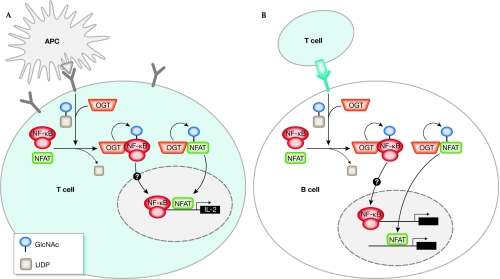Figure 3.
Model of O-linked N-acetylglucosamine modification during lymphocyte activation. (A) Activation of T lymphocytes through the T-cell receptor (TCR) leads to the association of the transcription factors known as nuclear factor of activated T cells (NFAT) and nuclear factor-κB (NF-κB) to O-linked N-acetylglucosaminyltransferase (OGT) and their O-GlcNAc modification. The transient O-GlcNAc modification enhances the nuclear translocation of NFAT (and probably also that of NF-κB). Nuclear localization and activation of NFAT and NF-κB is needed for the transcriptional activation of many genes, such as interleukin-2 (IL-2). (B) Activation of B lymphocytes through the B-cell receptor (BCR) leads to the association of the transcription factors NFAT and NF-κB to OGT, and their O-GlcNAc modification. The transient O-GlcNAc modification enhances the nuclear translocation of NFAT (and probably also that of NF-κB). Nuclear localization of NFAT and NF-κB is crucial to the reprogramming of B cells. APC, antigen-presenting cell; O-GlcNAc, O-linked N-acetylglucosamine.

